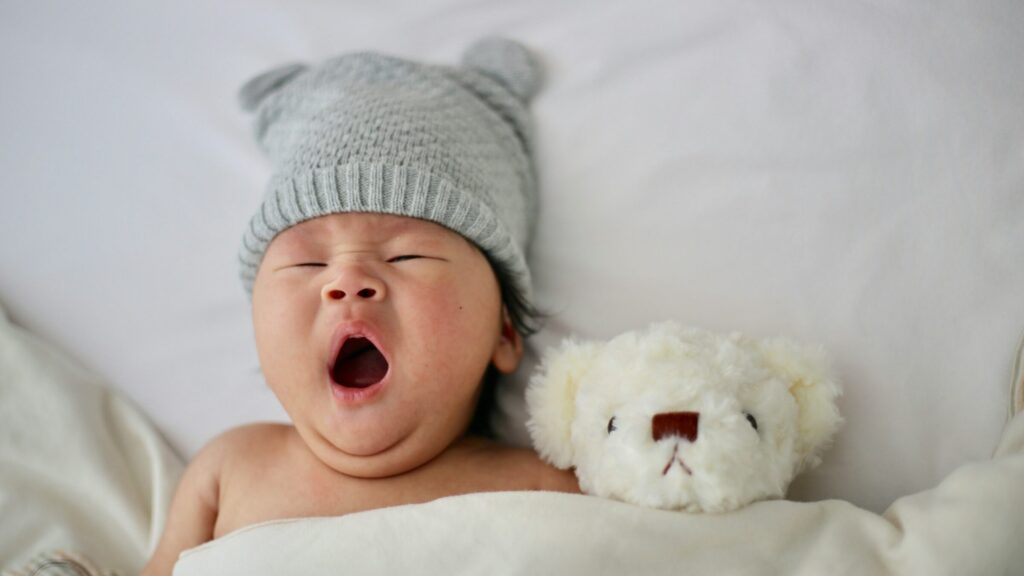White noise machines have become a staple in many modern nurseries in the UK. Parents often swear by them as a way to soothe unsettled newborns, block out noisy environments, and help babies sleep for longer stretches. While the benefits sound appealing, many caregivers still wonder whether white noise is safe for babies and if there are any hidden downsides.
In this guide, we will look closely at what white noise is, why it can be helpful, potential risks, how to use it safely, expert recommendations, and practical tips for parents. We will also include UK-based resources, charts, and advice so you can make an informed decision for your family.
What Is White Noise?
White noise is a consistent sound that contains all audible frequencies at the same intensity. It might sound like static, a fan running, rainfall, or ocean waves. Many white noise machines also provide options such as pink noise, brown noise, or nature sounds, which have slightly different sound profiles but serve a similar purpose.
For babies, white noise can mimic the environment they were used to before birth. According to NHS, the womb is far from quiet. The sound of blood rushing, the mother’s heartbeat, and digestive noises can reach around 70 to 80 decibels. This constant background hum is why newborns may feel more at ease when hearing steady noise rather than complete silence.
Why Parents Use White Noise Machines
UK parents turn to white noise machines for a variety of reasons:
-
To mask environmental noise from siblings, pets, or traffic
-
To soothe babies who struggle to settle
-
To support naps in noisy environments such as during travel or in shared living spaces
-
To establish a consistent bedtime routine where the sound acts as a sleep cue
“We live in a flat on a busy road, and white noise has been a lifesaver. It stops my son from waking up every time a bus goes past,” says Laura, a mum from Manchester, on Mumsnet.
Safe Sound Levels for Babies
A common concern with white noise machines is whether they can harm a baby’s hearing. Experts warn that the volume and distance from the baby are critical factors.
The National Institute for Health and Care Excellence (NICE) and paediatric audiologists recommend keeping prolonged noise levels for infants below 50 decibels.
Decibel Reference Chart
| Decibel Level | Comparable Sound | Safe for Babies? |
|---|---|---|
| 30 dB | Whisper | ✅ Safe |
| 50 dB | Quiet conversation | ✅ Safe |
| 60 dB | Normal conversation | ⚠ Use caution |
| 70 dB | Vacuum cleaner | ❌ Too loud |
| 85 dB+ | Hair dryer, blender | ❌ Unsafe |
Pro Tip: Place the machine at least 1 metre from the cot and test the sound with a decibel meter app to ensure it is in the safe range.
Pros of Using a White Noise Machine for Babies
1. Helps Babies Fall Asleep Faster
White noise can help calm a restless baby and reduce the time it takes them to drift off.
A study in Archives of Disease in Childhood found that 80% of newborns exposed to white noise fell asleep within five minutes, compared with only 25% in a control group.
2. Masks Sudden Noises
Sudden sounds can wake a baby from light sleep. White noise creates a buffer that reduces the likelihood of startle reflex waking.
3. Acts as a Sleep Cue
When used consistently, the sound becomes part of a bedtime routine, signalling that it is time to sleep.
4. Comforts Newborns
The sound environment in the womb was never silent, so the familiar hum can help babies feel secure.
5. Can Improve Sleep for the Whole Family
If your baby sleeps better, everyone else in the household is more likely to rest well too.
6. Useful for Travel or New Environments
When away from home, the familiar sound can help a baby settle more quickly in an unfamiliar space such as a hotel room or relative’s house.
Dreamegg White Noise Machine with Night Light
The Dreamegg White Noise Machine is a compact and portable device that’s well suited for both nursery use and on the go nap times. What stands out is its broader collection of sound settings, from fan like noises to nature sounds and even lullabies.
It also includes a soft, adjustable night light, making it perfect for night feeds and nappy changes without turning on harsh ceiling lights. It’s USB rechargeable and super travel friendly, so you’re never caught out without sleep support again.
Dreamegg White Noise Machine with Night Light
Cons of Using a White Noise Machine for Babies
1. Potential Dependency
If used for every nap and bedtime, babies might come to rely on white noise to fall asleep, making it harder to sleep in silence later on.
2. Hearing Risks if Volume Is Too High
Placing the device too close to the cot or turning the volume too high can exceed safe noise levels.
3. Not a Cure All for Sleep Issues
White noise cannot resolve problems caused by hunger, teething, illness, or an uncomfortable sleep environment.
4. Limited Research on Long Term Effects
While short term use appears safe, there is little evidence about the effects of daily use over several years.
5. Possible Overstimulation
Some babies may find certain types of white noise irritating, particularly if the pitch is too high or the sound too busy.
Tommee Tippee Dreammaker Sound and Light Machine
The Tommee Tippee Dreammaker is built with science in mind. Its pink noise sounds are designed to slow baby’s heart rate, helping them settle faster and sleep deeper. Unlike traditional white noise, pink noise has lower high-frequency components — making it lighter on baby’s ears.
It also has gentle light pulses that mimic rhythmic breathing to subconsciously encourage your baby to relax. It’s ideal if you’re looking for a holistic sleep solution, not just noise but visual and biological rhythm aids too.

Tommee Tippee Dreammaker Baby Sleep Aid
How to Use a White Noise Machine Safely
Safe use comes down to three key factors: volume, distance, and timing.
-
Set the volume under 50 dB using a decibel app for accuracy.
-
Position the machine at least 1 metre from the cot to reduce sound intensity.
-
Use it only during sleep times to avoid over reliance.
-
Choose soothing, consistent sounds rather than sharp or high-pitched tones.
-
Consider a timer function so it turns off once your baby is in deep sleep.
| Tip | Why It Matters |
|---|---|
| Keep volume under 50 dB | Protects hearing |
| Place at least 1 metre from cot | Reduces intensity |
| Use only during sleep times | Avoids over reliance |
| Choose consistent sounds | Prevents overstimulation |
| Use a timer | Encourages self settling |
Parent Tip: “We use the rain sound option on low volume and set it to stop after 45 minutes. Our son now sleeps through without it for the rest of the night.” – Emma, London
Sweet Dreamers Rechargeable Ewan Deluxe
We seriously love this adorable little sheep (and our bub does too!). The Sweet Dreamers Rechargeable Ewan Deluxe combines white noise with a soft red night light that helps stimulate melatonin production. It also features a “smartCRY” sensor, meaning it automatically activates when your baby stirs — giving you a break from manual restarts.
Best of all, it has multiple sound options like womb noises, rainfall, and harp melodies, so you can customize based on your baby’s mood. It’s machine washable and rechargeable too (hooray for fewer batteries!).

Sweet Dreamers Rechargeable Ewan Deluxe
Alternatives to White Noise Machines
If you are concerned about dependency or cost, you could try:
-
Apps such as Sound Sleeper or Baby Sleep Sounds (free or low-cost, portable)
-
Household sounds like fans or air purifiers (dual-purpose but less portable)
-
Nature recordings such as rainfall or ocean waves (calming, varied options)
-
Lullabies at a low volume (soothing but may stimulate if too melodic)
Each alternative comes with its own pros and cons. Apps are flexible but require a device nearby. Household sounds are consistent but may be harder to control in volume. Nature recordings are calming but can vary in quality. Lullabies are gentle but might keep some babies alert instead of sleepy.
Frequently Asked Questions
Is white noise safe for newborns?
Yes, provided it is kept below 50 dB and placed away from the cot.
Can I leave white noise on all night?
You can, but many experts suggest using it until your baby is in deep sleep and then turning it off.
When should I stop using white noise?
Some parents choose to stop between 12 and 18 months, while others use it for several years without issue.
Can white noise help with naps?
Yes, it can help block daytime noise and create a calming environment for naps.
Is pink noise better than white noise?
Pink noise has a softer sound profile and can be more soothing for some babies, but both are effective.
Can white noise harm development?
There is no strong evidence that safe use harms development, but long term studies are limited.
What if my baby dislikes white noise?
Some babies may prefer music, lullabies, or complete silence, so experiment to find what works best.
Do I need a special machine or will an app work?
Apps can work well if you can control volume and keep the device a safe distance away.
Can I use white noise during playtime?
It is better to save white noise for sleep periods so your baby learns to associate it with rest.
What is the difference between white noise and brown noise?
Brown noise has more emphasis on lower frequencies, making it deeper and often more relaxing for some people.
Final Thoughts
White noise machines can be a useful part of a baby’s sleep routine when used safely. Keep the volume low, place the device at a safe distance, and make it part of a calming bedtime environment rather than a constant background sound.
Every baby is unique, so observe your child’s response and adjust your approach to suit their needs. With safe use and a balanced routine, white noise can help your baby and you get more restful sleep.




